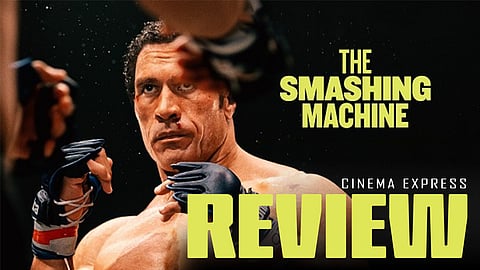The Smashing Machine Movie Review: A terrific sports film and an even better character study
The Smashing Machine(3.5 / 5)
The Smashing Machine Movie Review:
They say, “Nice guys finish last.” Mark Kerr may be a great mixed martial artist in the ring, but is he really a nice person outside of it? The answer is perhaps no, but the best thing about director Benny Safdie’s The Smashing Machine is that it never gives you any easy answers. The film is uncompromising in its approach towards unravelling the layers behind this “250-pound monster”, as an MMA announcer describes him. In the opening monologue of Safdie’s film, we see Kerr (Dwayne Johnson) beating his opponents to a pulp, as if he is in a fit of rage and is out there to take out all his frustrations. In the background, we hear the fighter say that he gets a high from doing what he does. Later, Kerr tells his wife, Dawn Staples (Emily Blunt), that he gains a sense of “orgasm” from winning a battle and listening to thousands of people chanting his name.
Kerr is more of a monster in his private life than he is in the ring. The Smashing Machine chronicles Kerr’s professional and personal life a little like how Martin Scorsese’s Raging Bull shows Jake LaMotta’s life. The MMA fighter’s personal life plummets to extreme lows even as his boxing career takes a leap forward. However, there is one major difference between Kerr and LaMotta. Where LaMotta would take an insult from his wife the night before a big fight and let it out on his opponents, any argument with his wife adversely affects Kerr’s performance.
Director: Benny Safdie
Cast: Dwayne Johnson, Emily Blunt, Ryan Bader
The Smashing Machine is smart in terms of how it makes you look at both characters’ points of view in the way great films about an unhealthy marriage usually do. The film avoids making any facile judgements about Kerr or his wife, instead providing a comprehensive portrayal of their relationship. For example, when Staples has a go at Kerr for not paying enough attention to her, she accidentally reminds him about the fight he just lost. What makes it fascinating is that the argument comes shortly after the officials annul the fight he supposedly lost based on a fault by his opponent. An angry Kerr punches a hole through the door next to him while shattering all paraphernalia in the process. The fighter’s anger seems to stem equally from his frustration for losing a fight that he feels he should not have lost and for realising that his wife does not understand how the mind of an athlete like him works. After all, nobody wants to be told, “You lost,” from someone close, even if that 'failure' is based on a technicality. Just like no one wants a complete lack of attention from their partner, either. Both Staples and Kerr have equal reasons to hate each other.
Safdie deserves appreciation for the quality of writing on display here, beyond the marriage portions. He doubles up as the film’s editor, which contributes to compelling viewing because of the little details that find their way into the film. The Kerr-Staples fights could have easily been one-sided, leaving the female perspective a little diluted, if not for his astute screenplay and editing for the boxing portions. Safdie’s work ensures that you get to see what Kerr is like inside the ring, helping you form an all-around idea as to who he is. Notice how the artist applauds his opponent after winning a fight for the latter’s earnest, albeit unsuccessful, effort to defeat him. When the time comes for him to lose, however, Kerr storms off the arena without appreciating his opponent. Great athletes stay gracious in defeat as well. The fighter makes a jibe at another opponent, who beats him, albeit with a foul move, for the stitches he left just above his eyebrow. Kerr asks his opponent to lift the gauze so that he can see the stitches for himself. As he takes one look at it, Kerr tells him, “Nice”.
The factor that makes The Smashing Machine an even more intriguing document of Kerr’s life is Johnson’s performance in the lead role. Johnson is virtually unrecognisable after all the weight he has gained to look the part. He also disappears into the role. The actor is at his best in those little moments where Kerr makes a passing look at his opponent that reeks of some disingenuity, or the ones where he has a big altercation with his wife. On the other hand, he throws his weight behind his best friend and fighter Mark Coleman (a solid Ryan Bader), who gets back into MMA for another shot at glory.
However, the film is not without its flaws. The one minor quibble to have with the film is its ending. After taking in all the blows and giving some back, Johnson does not deserve to be sidelined by the real Mark Kerr. Safdie also uses a piece of text just to tell the whole world who this man is, what his legacy is, and what the film is all about. Come on, we get it. However, do not let this minor blemish spoil the film for you. The point of a sports film is to entertain you and make you curious enough about its subject at the very least. In that regard, The Smashing Machine does its job well enough while packing quite the punch.


